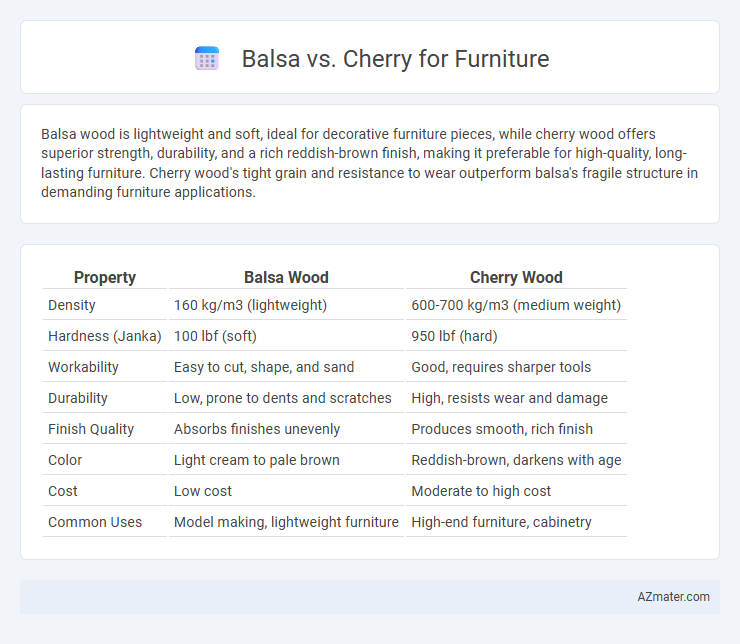Balsa wood is lightweight and soft, ideal for decorative furniture pieces, while cherry wood offers superior strength, durability, and a rich reddish-brown finish, making it preferable for high-quality, long-lasting furniture. Cherry wood's tight grain and resistance to wear outperform balsa's fragile structure in demanding furniture applications.
Table of Comparison
| Property | Balsa Wood | Cherry Wood |
|---|---|---|
| Density | 160 kg/m3 (lightweight) | 600-700 kg/m3 (medium weight) |
| Hardness (Janka) | 100 lbf (soft) | 950 lbf (hard) |
| Workability | Easy to cut, shape, and sand | Good, requires sharper tools |
| Durability | Low, prone to dents and scratches | High, resists wear and damage |
| Finish Quality | Absorbs finishes unevenly | Produces smooth, rich finish |
| Color | Light cream to pale brown | Reddish-brown, darkens with age |
| Cost | Low cost | Moderate to high cost |
| Common Uses | Model making, lightweight furniture | High-end furniture, cabinetry |
Understanding Balsa and Cherry Wood
Balsa wood is an extremely lightweight hardwood prized for its low density, making it ideal for model building and lightweight furniture components, though it lacks the durability and hardness of traditional hardwoods. Cherry wood, a dense hardwood with a rich reddish-brown color, offers exceptional strength, fine grain, and excellent workability, making it a popular choice for high-quality, long-lasting furniture. Understanding the differences in weight, hardness, and aesthetic qualities between balsa and cherry wood helps determine their suitability for specific furniture applications.
Key Differences in Appearance
Balsa wood features a very light color with a pale cream tone and exhibits a fine, even grain that often appears smooth and soft. In contrast, cherry wood boasts a rich reddish-brown hue that deepens with age and sunlight, showcasing a more pronounced, wavy grain pattern that adds character to furniture pieces. These distinct color and grain disparities influence the aesthetic appeal and style choices in furniture design, with balsa lending a light, airy look and cherry providing warmth and elegance.
Strength and Durability Comparison
Cherry wood offers superior strength and durability compared to balsa, making it a preferred choice for long-lasting furniture. Balsa is significantly lighter and softer, which results in lower resistance to wear, dents, and impacts over time. The dense grain structure of cherry enhances its ability to withstand daily use and structural stress, ensuring furniture retains its integrity and appearance for decades.
Weight and Handling Characteristics
Balsa wood is exceptionally lightweight, making it ideal for furniture pieces that require easy handling and frequent movement, whereas cherry wood is denser and heavier, offering greater durability and a solid feel. The low density of balsa allows for effortless lifting and transport, but its softness makes it less suitable for high-traffic furniture that needs to withstand wear. Cherry wood's robust structure provides superior resistance to dents and scratches, balancing weight with long-lasting performance in both traditional and modern furniture designs.
Workability and Ease of Crafting
Balsa wood is highly favored for furniture making due to its exceptional ease of crafting, being lightweight and soft, which allows for quick cutting, shaping, and sanding without requiring heavy-duty tools. Cherry wood, although denser and harder than balsa, offers excellent workability with smooth grain and consistent texture, enabling fine detailing and a polished finish when worked with sharp tools. In comparison, balsa is ideal for rapid prototyping and light furniture pieces, while cherry is preferred for durable, high-quality furniture that benefits from its robust nature and ease of finishing.
Cost and Availability
Balsa wood is significantly less expensive and more readily available than cherry wood, making it a budget-friendly choice for lightweight furniture projects. Cherry wood, prized for its rich color and durability, commands a higher price due to its slower growth rate and limited regional availability. Cost considerations favor balsa for economical production, while cherry's premium pricing reflects its status in luxury and long-lasting furniture designs.
Suitability for Different Furniture Types
Balsa wood, known for its lightweight and softness, is best suited for decorative furniture, model making, or lightweight panels where strength is less critical. Cherry wood offers greater durability and a rich, warm tone, making it ideal for high-quality cabinetry, dining tables, and heirloom furniture requiring long-term resilience. The choice between balsa and cherry depends largely on the furniture's functional demands and aesthetic goals.
Maintenance and Longevity
Balsa wood requires minimal maintenance due to its lightweight and soft texture, but it is less durable and prone to dents and scratches, making it less suitable for high-traffic furniture. Cherry wood offers excellent longevity, developing a rich patina over time and resisting wear, which makes it a popular choice for heirloom-quality pieces. Regular polishing and careful cleaning help maintain cherry furniture's appearance and extend its lifespan significantly.
Environmental Impact and Sustainability
Balsa wood is renowned for its rapid growth rate, making it a highly renewable resource with a lower environmental footprint compared to slower-growing hardwoods like cherry. Cherry wood, while durable and visually appealing, often requires longer harvesting cycles, contributing to deforestation concerns and less sustainable forestry practices. Sustainable sourcing certifications such as FSC (Forest Stewardship Council) are crucial when choosing cherry to ensure responsible environmental stewardship and reduced ecological impact.
Choosing the Right Wood for Your Furniture
Balsa wood offers exceptional lightweight properties and is ideal for furniture pieces requiring easy handling and portability, while cherry wood provides superior strength, durability, and a rich, warm color that deepens with age, making it perfect for heirloom-quality furniture. Consider the intended use, weight requirements, and aesthetic preferences when choosing between balsa and cherry; balsa suits decorative or lightweight applications, whereas cherry excels in structural and long-lasting furniture. Selecting cherry wood enhances furniture longevity due to its density and resistance to wear, whereas balsa's softness limits its durability for heavy-use items.

Infographic: Balsa vs Cherry for Furniture
 azmater.com
azmater.com